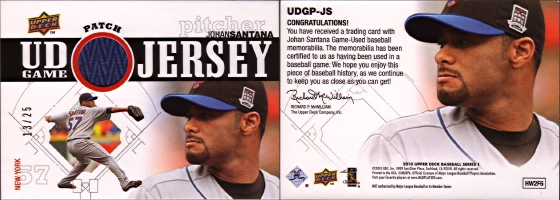Milestones and the end of the road
Remember when I started this blog with the first entry in this series? Probably not, that was almost a year ago… I’m going out of sequence with the second part because the second part chronologically (1998-1999) is pretty boring. Instead, I’m going straight to 2010 with a card from an insert set that started in 1999 featuring a player whose first game-used cards appeared in 1998. So yeah, we’re still kinda in 1998-1999 for this piece.
Gary Sheffield has been a personal favorite of mine (as much as I was ever able to have favorites before R.A. Dickey came along) for a long time now, dating back to the day I pulled his error rookie card out of a pack of 1989 Upper Deck. It is fitting then that Sheffield is also the player that I associate with 2010 Upper Deck Series 1, the final major baseball card product from what was once the most innovative sports card manufacturer on the planet. I was thrilled when Sheff was picked up by the Mets in 2009 after being released by the Tigers, not because he was a superstar player (his best days were long behind him), but because of the wealth of game-used cards he had amassed over his career. Between countless teams and several All-Star games, Sheffield had been one of the most prolific game-used subjects over the previous decade. It didn’t hurt that he was Dwight Gooden’s nephew either.

Oh, right, he was also on the verge of hitting his 500th home run. No Met had ever hit a 500th home run, so that would be a first. The baseball card connection here is Upper Deck’s A Piece of History 500 Club game-used bat insert set, the longest-running game-used insert set in history. Started in 1999 with cards spread out over several products over the next few years until the present club was complete, with new cards showing up as new players hit the 500 home run milestone, the 500 Club bat card set would finish in 2010 with Sheffield as the final member to be recognized. As you can see, he appeared in a Mets uniform, the only member of the club so attired. And that’s kind of the problem.
You see, MLB Properties has a soft spot for monopolies and thought it would be swell to have just one officially licensed baseball card manufacturer starting in 2010. With two manufacturers still licensed by the MLB Players Association in 2009, the finalists were the old standard Topps and the brash 20 year old upstart Upper Deck. MLB Properties went with Topps and forced Upper Deck into the unlicensed card market formerly occupied by Donruss. The loss of the MLB license meant that Upper Deck would no longer be able to use MLB team logos and names. Most companies in this position take extreme measures to airbrush/photoshop out anything and everything that could be considered a logo or property of MLB Properties. As you can see above, Upper Deck went with angles and cropping that obscures the logos but doesn’t hide them completely. While that’s pushing the limits of legality, they should still be safe, right? Well, only if MLB doesn’t look on the back of the card.

And right there are the Mets sleeve and helmet logos in plain view, with no attempt made to get rid of them. To its credit, UD did include the statement “NOT authorized by Major League Baseball or its Member Teams,” but I don’t think a capital NOT is going to pass legal muster. For a second opinion, let’s consult with Johan Santana.

It’s almost like they were trying to put as much of the logos on the card as possible without being overt about it. Between the two cards, we’ve also got the complete Citi Field Inaugural Season sleeve and hat logos in full view, which probably isn’t helping matters any. That’s just asking to get your pants sued off, which is precisely what MLB Properties did. As is the norm these days, they agreed on a settlement in lieu of an actual trial. The terms included some cash (which UD was late paying) and an agreement that Upper Deck would not use any MLB Properties logos in the future (which they shouldn’t have been doing anyway) and would not use photographs that had been altered to remove or obscure any MLB Properties logos (which they clearly had no interest or ability in doing in the first place). In exchange, Upper Deck wouldn’t have to recall any infringing products that had already been shipped. Everybody wins!
This all but spelled the end of Upper Deck as a baseball card manufacturer. Losing the MLB Properties license was a big blow, but other companies like Playoff/Donruss, Panini/Donruss, and Razor/Leaf have gone on without licenses. In the event that MLB Properties reconsiders granting an exclusive license, there would be a chance of being reinstated. Well, except for the whole snubbing their nose at MLB Properties and the law and napalming that bridge. There’s no coming back from that kind of mess.
But at least we have this snazzy un-photoshopped Gary Sheffield bat card.
Comments are closed.